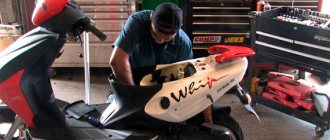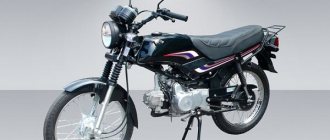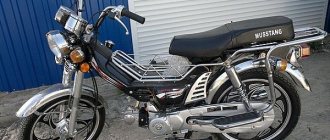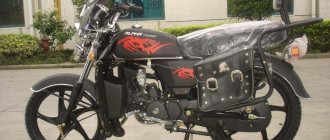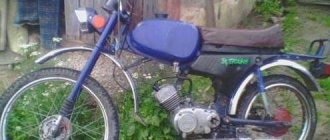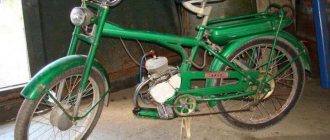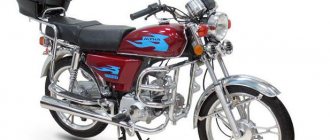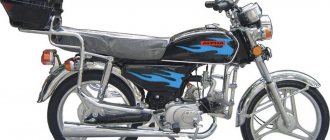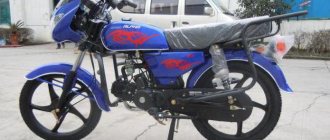The Lviv Motor Plant, which produced the Verkhovyna moped, initially specialized in the production of car trailers. The development and production of experimental small-capacity mokiks began in 1958. The first examples in this direction were motorized bicycles. Then “Verkhovyna 3” appeared, which played a significant role in the development of domestic motor vehicles of those times. The car was equipped with a two-stroke engine with a volume of 50 cubic centimeters. The engine power was two horsepower, and its acceleration dynamics allowed it to reach a speed of about 50 km/h. The filling of the unit was typical for its class, so the developers focused on the improved design of the equipment.
Characteristics
A distinctive feature of the Verkhovyna 3 moped from its predecessors are the wheels of a smaller diameter, as well as a welded tubular frame. Thanks to this design, it was possible to increase the power of the unit and reduce its weight to 51 kilograms. On two-wheeled vehicles, a modernized front fork appeared, and the landing also improved. The rear fork was fixed to the frame using threaded bushings and bolts. This made it possible to reduce the degree of wear of the element during swinging. Protective stops appeared on the brake pads with the ability to change or replenish compensating washers, which extended the service life of the unit.
On the first versions, the fuel tank was fixed on brackets, and on the Verkhovyna moped it was attached to a collar. This solution made it possible to avoid the appearance of cracks on fasteners. Before going into production, the mokik in question underwent a series of tests, covering a total of more than five thousand kilometers. From 1972 to 1974, the 4th and 5th series of this equipment were released. They differed in engine parameters and minor design alterations.
Sixth version
In the line under consideration, special attention should be paid to the Verkhovyna 6 moped. Here we can already talk about a radically different category. First, bicycle pedals were replaced with a kick starter. Secondly, the unit was equipped with a 2.2 horsepower two-stroke power unit, a two-speed gearbox with controls on the left side of the steering wheel, and the exterior was slightly modified.
The high steering wheel and enlarged seat ensured a comfortable and soft landing. At the same time, wide tires and a soft, updated suspension ensured ease of movement on difficult roads. The trunk remained in its place and could withstand a load of 15 kg without any problems.
The new mokick became more than three kilograms heavier, but this did not affect its maneuverability and speed parameters. In 1981, the seventh version appeared, equipped with a motor with a contactless ignition unit, a new carburetor and a powerful generator. Despite all the innovations, the speed of this unit was only 40 km/h. Among the changes, we can note improved lights and the placement of control devices on the steering wheel.
Description
Mopeds are vehicles that are similar in appearance to motorcycles, but are much weaker in technical terms. “Verkhovyna 6” is the brainchild of the Lviv Motor Plant. The model was developed and released in 1977. At one time it was very popular. The micromotorcycle was in great demand among different categories of the population. This model has gained particular popularity in villages and villages. In rural areas, “Verkhovyna 6” became an indispensable “comrade” on which you could go fishing and pick mushrooms. Since the installation of the S-58 engine from the Siauliai plant, the quality of mopeds has noticeably deteriorated. This played a big role and mopeds began to lose demand.
Externally, this moped resembled a motorcycle, only in a compact version. The unit is intended for one driver only. In addition, it was possible to transport 15 kg of cargo at the same time. The moped was characterized as easy to operate, maneuverable and affordable. On this model, unlike all previous Verkhovyna mopeds, pedals were eliminated. Only a kick starter was provided.
Options
Below are the technical characteristics of the Verkhovyna moped of the sixth series:
- The type of power unit is a gasoline carburetor two-stroke engine.
- Working volume – 49.8 cubic centimeters.
- Compression – 8.5.
- The piston stroke is 44 mm with a diameter of 38 mm.
- Power type: gasoline mixed with oil.
- Power indicators – 2.2 hp. forces at 5200 rpm.
- Ignition of the Verkhovyna moped is a contact type, aggregating with an alternating current generator.
- Transmission – manual gearbox with two ranges and a chain gearbox.
- Length/width/height – 1.77/0.72/1.2 m.
- Clearance – 10 cm.
- The brake system is drum type.
- Suspension – front – telescope, rear – pendulum block with springs.
- Weight – 53.5 kg.
- Fuel consumption per 100 km is about 2.2 liters.
Moped Verkhovyna 6
“Verkhovyna” was the name of a large series of motorbikes and mopeds produced by the Lviv Motorcycle Plant. The history of this series began in 1958, when several tens of thousands of Verkhovina - 3 mopeds were produced. Then there were Verkhovina - 4, Verkhovina - 5, and finally in 1978, the hero of our review, the Verkhovina 6 moped, was born. It could carry one person and 15 kilograms of cargo. For its time, it was a very necessary vehicle: the moped was easy to operate and maintain, and was also affordable from a financial point of view.
Mopeds were intended largely as a replacement for a bicycle, and were structurally similar to them in the form of ordinary bicycle pedals for starting the engine. For the first time in the entire LMZ product line, Mokik Verkhovina 6 had a kickstarter instead of pedals. We can say that this model was a real miniature motorcycle, differing from its “big” brothers only in its small engine capacity and light weight. Verkhovina 6 was equipped with Sh57 or Sh58 two-stroke carburetor engines. The engine is air-cooled, power 2.2 horsepower. Contact ignition, powered by an alternating current generator, equipped with a high-voltage transformer. The cylinder displacement of 49.8 cubic centimeters allows the moped to enter the class of machines that do not require a driver's license to operate. The Mokika transmission consists of a multi-plate clutch operating in an oil bath and a two-speed manually operated gearbox.
The chassis of the moped is represented by a tubular welded frame, rear pendulum suspension and front telescopic fork with spring shock absorbers. The brakes on both wheels are drum. The comfortable, elongated saddle made it possible to comfortably make even relatively long journeys. To transport luggage, the design provided a special trunk with a carrying capacity of fifteen kilograms. For driving at night there were two headlights. The design of the moped was the most modern at that time, very beautiful and elegant.
Specifications
| Engine | Petrol |
| Volume | 49,8 |
| Cylinder diameter and stroke, mm | 38x44 |
| Compression ratio | 7,5-8,5 |
| Nutrition | A mixture of gasoline and oil |
| Ignition | Contact from alternator |
| Power | 2.2 hp at 4400-5200 rpm |
| Gearbox/Drive | Two-stage, main gear - chain |
| Length, mm | 1770 |
| Width, mm | 720 |
| Height, mm | 1200 |
| Base, mm | 1120 |
| Ground clearance, mm | 100 |
| Frame | Tubular, welded |
| Front suspension | Telescopic fork with spring shock absorbers |
| Rear suspension | Pendulum with spring shock absorbers |
| Front brake | Drum |
| Rear brake | Drum |
| Front wheel | 2,50-16 |
| Rear | 2,50-16 |
| Carburetor | K60 or K35V |
| Weight | 53,5 |
| Fuel consumption | 2.2 liters per 100 kilometers at a speed of 30 kilometers per hour |
Moped "Karpaty"
"Verkhovyna" received a worthy competitor in the spring of 1981. This season, one of the most significant models was released - “Karpaty”. The Mokik was equipped with a tubular frame, a telescopic fork with spring shock absorption, as well as a pendulum-type rear suspension and interchangeable wheels.
The new unit was equipped with a Sh-58 engine, with a volume of 50 cubic centimeters and a power equal to two horses, or an improved analogue of the Sh-62 with a contactless ignition system. The speed limit of this vehicle was 45 km/h. “Karpaty” was very similar in design to the Riga “Delta”.
Comparative review
Among the main differences between “Verkhovyna” and “Karpaty” was the presence of a modified shape of the fuel tank, muffler and side casings in the latter mokik. The designers increased the warranty period to 8 thousand kilometers, while for Verkhovyna it did not exceed 6 thousand. The service life increased by 3 thousand kilometers before the first major overhaul.
Despite the outdated Soviet technologies, the equipment in question at that time was the flagship in its class and had decent characteristics. Another advantage is that the repair of the Verkhovyna moped could be done with your own hands, without the use of special tools. Most often, this was needed by the “engine”, which the craftsmen sorted out, modernized and used again. Fortunately there were no problems with spare parts.
It so happened that this specimen lay in the attic of a private house for almost 40 years. This fall, the owners started repairing the roof, and the craftsmen accidentally discovered a moped under the rubble in its original form and with a mileage of 835 km. They took it out, washed it, pumped up the tires, and filled it with gasoline. And... he earned it. And today it will allow us to travel back to the distant 70s, when Verkhovyna-6 was a cult model that teenagers throughout the country dreamed of.
Actually, the choice in those days was not great: either mopeds from the Riga Motor Plant or Lviv Verkhovyna. There were also ZIF-type motorbikes, but these were no longer considered so cool.
This copy of LMZ-2.158-1 “Verkhovina-6”, thanks to its attic preservation, turned out to be in very good condition. There are almost no traces of corrosion, and the short period of operation helped to preserve it in its original form. Those who are used to watching reviews in video format specially filmed this one. Read the text version below.
Let's look at the find.
First, a little history. “Verkhovyna-6” is the first production moped launched from the kickstarter of the Lviv Motor Plant. This is why it is correct to call it a mokick, and not a moped. Although in those days all such small-capacity equipment was called mopeds, and from now on I will also call it a moped. It's more common this way.
Model LMZ-2.158 “Verkhovyna-6” appeared in 1977 and became a continuation of the idea of a moped, as a motorcycle in miniature, laid down in “Verkhovyna-5”. There was already a horizontally installed tank of increased capacity (7.5 l), with which it was possible to travel long distances. Also carried over from the previous model are the comfortable one-and-a-half seat and trunk with a load capacity of 15 kg. Verkhovina-6 had a slightly different design of the linings on the tank, which made the moped visually lighter.
Verkhovyna-5 still had bicycle-type pedals
The main difference was in the new Sh-58 engine from the Kovrov plant. Lviv motorcycles finally moved away from the pedal drive for starting, and a kick starter appeared on mopeds. Since 1980, Verkhovyna-6 was also equipped with an Š-58 engine from the Siauliai plant, with which they were mainly exported.
The characteristics of these engines were approximately the same: displacement 48 cm3, power 2.2 hp. The gearbox is 2-speed, with a drive on the steering wheel. The Verkhovina-6 moped had a maximum speed of 50 km/h, although the most desperate claimed that they managed to “put the needle over 60” - the maximum indicator on the moped’s tiny speedometer.
The emblem of the Verkhovyna and Carpathians line resembles Peugeot
The new design and the absence of the need to obtain a license and register the moped contributed to the enormous popularity of Verkhovyna-6 among young people. It is at Verkhovyna-6 that the 2,000,000th moped has been produced since the start of operation of the Lviv Motorcycle Plant. Teenagers from the age of 12 began to pester their parents with requests: “Buy, buy.” And those who were especially persistent eventually managed to break them.
The price of the basic version started at 220 rubles, and the “Lux” version with chrome rims, wheel guards and trunk cost 226 rubles.
A brand new moped was a source of special pride and a ticket to the motorcycle world for the boys. And the owner of “Verkhovyna-6” was the first guy in the yard or in the village.
The guys immediately began to modernize their mopeds: they raised the muffler, strengthened the frames, and installed other shock absorbers. And what kind of decorations didn’t they hang on them?
Verkhovyna-6. Sport
By the way, the idea of motorcycle tuning was also caught at the Lviv Motorcycle Plant. At the end of 1978, pilot batches (500 vehicles each) of two new modifications of the Verkhovyna-6 moped were produced. The Verkhovyna-6 model was launched especially for young people. Sport". Unlike the basic one, it is equipped with a raised muffler with a safety shield, a bag for storing a tourist map, a cross-type steering wheel with a jumper, and a raised front wheel guard. The idea turned out to be very successful and “Verkhovyna-6. Sport" was immediately sold out. The price of this version was only 228 rubles.
Verkhovina-6 version. Tourist
The second modification is “Verkhovyna-6. Tourist" was intended for fishermen and travelers. It was distinguished by a windshield and pannier bags on the sides. But to repeat the success of “Verkhovyna-6. Sports” she couldn’t.
Lviv motorcycle from 1977 to 1981, when it was replaced on the assembly line by the next model - “Verkhovyna-7”, which became the last of the “line” of “Verkhovyna”. And since 1982, the plant switched to producing Karpaty mopeds.
You can hear the characteristic sound of that same “Verkhovyna-6” in the video.
Let's be honest, Verkhovyna-6 did not shine with any special dynamics. And she couldn’t, since it was aimed at teenagers who drove without a license. But especially desperate guys managed to attach a 125 cc engine from a Minsk motorcycle to the “Verkhovyna” and thereby turned them into “missiles”. Traffic police inspectors preferred not to pay attention to mopedists. What to take from them? No rights, no numbers, no way to check who owns it. But they still stopped me for an obvious traffic violation.
For many, Verkhovina-6 became a ticket to the world of technology, the first step. Surprisingly, this simple moped was able to give such emotions that the guys had enough for decades. At that time it was an iPhone, MacBook, Segway, hoverboard in one form. And when such a coveted moped was rolled out of the Sporting Goods store, there was no happier person on Earth at that moment!
In conclusion
Already in 1989, the number of small-capacity vehicles on two wheels produced by Lvov manufacturers amounted to almost 140 thousand units. This is taking into account the fact that in the 80s of the last century the plant reduced the production of these machines by almost half, due to a drop in demand. To attract buyers, new models began to be developed for lovers of fast driving (“Sport”) or motorcycle tourism (“Tourist” with a windshield). After the collapse of the Union, the plant practically ceased to exist and produce light motor vehicles.
